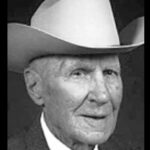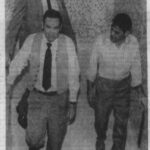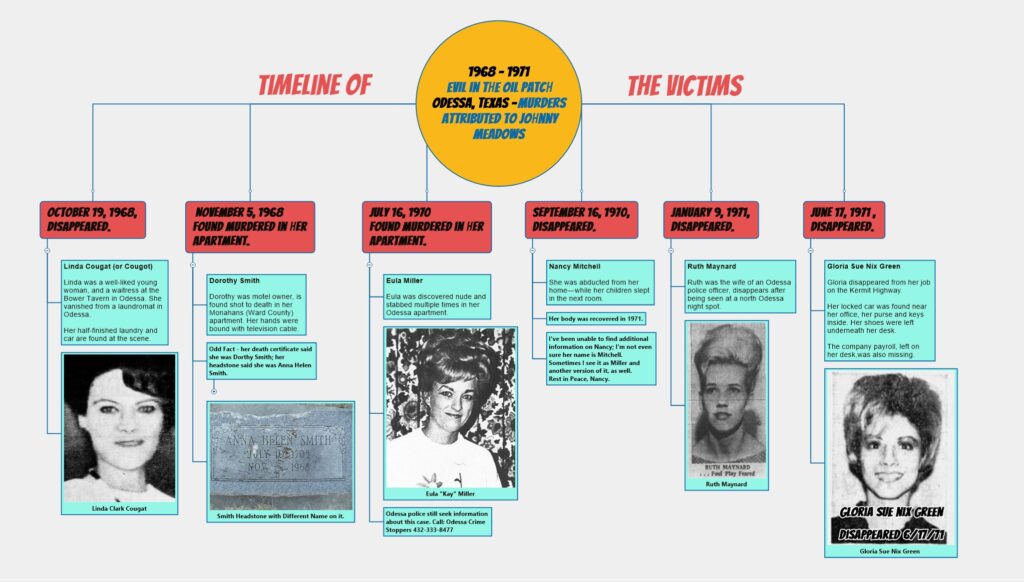Hi, it’s Brenda at Vintage Texas Crimes, and tonight I’ve got a story for you about Odessa in the summer of 1971.
Earlier this week, I noticed a pair of shoes lined up under my desk—and it sparked a memory. About six years ago, I came across an article in the Odessa American from June 1971. It told a grim story about a young woman who had gone missing from her job in Odessa. She worked as a dispatcher for an oilfield company, stationed in one of those temporary office buildings on an isolated road off the Kermit Highway.Back then, that stretch of road was desolate. It’s grown up since, but from the 1971 articles and photos, I got the sense her office sat in the middle of nowhere. I’ve included a photo of an Odessa oilfield here. If you’ve never seen one in person, it’s hard to imagine the desolation one could feel in those places.

West Texas Oilfield
In the West Texas oil patch of the early ‘70s, there was nothing but a grid of sandy dirt roads. The wind blew constantly, leaving everything and everyone coated in grit. The only landmarks were oil well pumps and the scattered temporary buildings—nearly identical in appearance.

Gloria Sue Nix Green Disappeared June 17, 1971
It was from that harsh and dusty setting that the pretty young dispatcher vanished—leaving behind her shoes, her purse, and her car.
That image stuck with me. The shoes were probably a pair of loafers, easy to slip on and off. I could see them in my mind—side by side on the floor beneath her desk, just waiting for her to come back. That’s a scene loaded with meaning. A woman doesn’t walk away from her desk and leave her shoes under it—especially not out there. To me, it screamed foul play.
I knew I wanted to write about her this week, but I couldn’t remember the year exactly. I only knew it was in the 1970s. I also couldn’t recall her name. I remembered a few details: she was in her twenties, a single mother, hardworking, and cautious. Her boss said she was “one of the good ones” and had been with the company for nearly four years. He said she didn’t run around with “the boys”—which I took to mean the roughnecks. He spoke of her with respect.
Still, I couldn’t track her down until I remembered one unusual detail about the case—something about the killer. A phrase stuck in my mind: branded initials. That was the key. I searched for it in the archives of the Odessa American, and a dozen articles popped up.
And just like that, I found her: 25-year-old Gloria Sue Nix Green. She went by Sue Nix. “Green” was the name of her ex-husband.
the missing woman was attractive and petite, at 5’2” and 110 pounds. She was a mother. She lived a quiet life and was close to her parents. She didn’t go out much, especially at night. Friends and family said her main concern was her little boy, Don Michael, who was just four years old.
Before I go further, I want to mention something remarkable. There’s actually video footage available from 1971 showing the killer being booked into jail and formally charged which is rare. I’ll put it right here. And, there’s another video linked at the bottom under the sources. [NOTE: TexasArchive.org is a non-profit historical website which has intermittent problems. If you see “502 Bad Gateway” where the video is supposed to be, they are having a bad day. Sorry!)
Let’s get into the story.
+++++
1968–1971: The Odessa Lust Killings
Evil in the West Texas Oilfields
+++++
Most Texans have heard the chilling tales of the Texas Killing Fields—those bleak stretches along I-45 between Galveston and Houston where girls and women vanished or turned up dead. If you grew up within a hundred miles of Houston, like I did, those stories were practically folklore. But until a few years ago, I had never heard about the string of brutal murders tied to the oilfields around Odessa in the late 1960s and early ‘70s.
Somewhere along the way, they earned the name: “The Odessa Lust Killings.”
I stumbled across the story while running keyword searches—things like murder, missing, abducted while looking for the topics I write about. To my shock, one 1971 edition of the Odessa American carried not one, but three major crime stories involving women and girls who had either vanished or been found murdered. I remember telling a friend, “This must’ve been a terrifying time to be a woman in Odessa.” The crimes weren’t scattered over years—they seemed to be in clusters and gave the appearance of a high crime rate.
Between 1950 and 1970, Odessa’s population exploded—from 29,000 to nearly 80,000. That kind of boom often outpaces a town’s infrastructure, including its police force. By 1971, it was clear there weren’t enough officers to keep up with the growing dangers—especially for women.
And then there was the killer.
He began in 1968 and stalked his victims in and around the oilfields—bold, unpredictable, and mobile. He abducted women in broad daylight or under the cover of night, raped and murdered them, and then dumped their bodies in remote areas where they might not be found for weeks or months—if ever.
The killer was deliberate and only abducted small women he could control easily. And worst of all, he was good at hiding their bodies. Really good.
According to the sources I’ll list at the bottom of this article, law enforcement didn’t realize they had a serial predator on their hands until June 1971—after the disappearance of 25-year-old Gloria Sue Nix Green. And even then, it came on the heels of several other unsolved cases, including women found dead in their own homes.
+++++
Victims (1968–1971)
+++++
• October 19, 1968: Linda Cougat, 24, a barmaid, vanishes from a laundromat in Odessa. Her half-finished laundry and car are found at the scene.
• November 5, 1968: Dorothy Smith, a motel owner, is found shot to death in her Monahans apartment. Her hands were bound with television cable.
• July 16, 1970: Eula Miller was discovered nude and stabbed multiple times in her Odessa apartment.
• September 16, 1970: Nancy Mitchell was abducted from her home—while her children slept in the next room.
• January 9, 1971: Ruth Maynard, wife of an Odessa police officer, disappears after being seen at a north Odessa night spot.
• June 17, 1971: Gloria Sue Green disappears from her job on the Kermit Highway. Her locked car was found near her office, her purse and keys inside. The company payroll, left on her desk,was also missing.
+++++
August 1971 – Missing: an 11-Year-Old Girl
+++++
Now, there was one more death of a female under investigation during 1971.
On August 23, 1971, Johnnie Janell Henderson, age 11, went missing from her home in the early morning hours. Her mother went to the store at 7:00 a.m. and when she returned, the kids were still asleep, except for Johnnie. Johnnie was missing from her bed. Police began to search; three days later, Johnnie was found 300 yards from the back gate of the fence of her own home.
Local men and boys were polygraphed, but no arrests were made. Cops wondered if this murder was related to the women who were missing and dead in the list above, but this murder was not solved that I can tell. I’m going to look into it later in the summer.
+++++
December 1971 – Game Changer: Phone Call from New Mexico
+++++

Sheriff A.M. (Slim) Gabrel
Odessa law enforcement had no leads in the disappearance of Gloria Sue Nix Green—or in the other cases—until a phone call came in from Aztec, New Mexico, in December 1971. The sheriff there wanted a word with Ector County Sheriff A.M. “Slim” Gabrel.
“We’ve got a prisoner here from over your way,” the New Mexico sheriff said. “He’s talking—telling big tales about murders in Texas, especially in Ector County.”
Sheriff Gabrel knew exactly who the caller was talking about. Johnny Meadows.

Johnny Meadows and Lawyer (clipped from TexasArchive.org)
Meadows was 34, a roughneck who’d been working the oilfields around Odessa at the time Gloria Sue Nix Green went missing. He was originally from Gladewater, a town in East Texas, but claimed he’d lived all over. He’d been in Odessa for about three years before Gloria vanished, and now he’d surfaced in Aztec, New Mexico—way up near the Colorado state line, about 600 miles from West Texas.
Gabrel had dealt with Meadows before. That past summer, Meadows had been held in the Ector County jail on a charge of disposing of mortgaged property. But law enforcement didn’t have enough to keep him—not on that charge, and certainly not on anything related to Gloria Green or the other women.
- Johnny Meadows in 1971
- Meadows in 1983 (age 46)
- Johnny Meadows and Lawyer (clipped from TexasArchive.org)
- Meadows Walks with Officials (no handcuffs or restraints)
He was a strong suspect because Meadows was connected to at least two victims. He had worked for the same company as Gloria Sue Nix Green worked for and it was established that they knew each other. In the case of Dorothy Smith—the motel owner found murdered in Monahans in November 1968—there was another link: Meadows’ wife, Delores, had worked at that same motel. And Johnny knew Dorothy Smith personally.
Sheriff Gabrel wasted no time. He flew to Aztec to question Meadows in person. By then, Johnny had been living there since November and was working at the San Juan County Hospital.
+++++
1968 – Roughnecking in Texas
+++++
Johnny Meadows stayed in Odessa for at least three years and he stayed there through mid-November 1971, working as a roughneck. Like many others, he’d come to West Texas for the oilfield money. No experience needed—just brute strength and the willingness to do hard, dirty work for long hours.
The money was good. That’s why people came. But it also brought in a wide mix of men—some of them were just looking for a paycheck. Others were drifters, loners, and outright criminals. That’s where the term “oilfield trash” comes from.
I can count five men in my own family who worked the Texas oilfields. They’d tell you it was a good place to get ahead on your bills if you didn’t mind the grind. But they knew this: there were some rough characters out there.
I don’t know if the pay is still good in the oilfield today. But back then, roughnecks made top dollar—sometimes even double-time on holidays. If you survived the job without a serious injury, it could be a real stepping stone.
My grandfather once fell out of a derrick and broke his back. But he recovered completely—and I never heard him complain about pain, not once. That was the kind of toughness oilfield work demanded.
As for Johnny Meadows, we don’t know if he left the oilfield because he couldn’t take the work—or because the noose was tightening, and he needed to get out of town before someone started asking the right questions.
+++++
December 1971 – Meadows’ Confession
+++++
The details from this part of the story come from multiple sources—some conflicting, some incomplete—but based on everything I’ve read, here’s how I believe it unfolded.
When Sheriff A.M. “Slim” Gabrel arrived at the San Juan County Jail in New Mexico, he asked Johnny Meadows if he remembered the women who had gone missing, and those found murdered back in Ector County.
Meadows said he did. Sheriff Gabrel kept him talking. And with each passing minute, the sheriff grew more certain: this man was the Odessa killer. Meadows knew too much, too many precise details about each woman’s case. Things only the killer could have known.
Gabrel learned that Johnny was worried about his family; specifically, Johnny didn’t know whether his wife and children had enough money to survive the next day much less the harsh winter in the northern part of New Mexico, so the sheriff made a bold move. He called Meadows’ wife, Delores, and offered her $2,000 in exchange for helping elicit a confession. (In 1971, $2,000 had the buying power that $15,792 does today.)
Delores was desperate and $2,000 was a huge amount for her. She agreed and called the jail to speak with Meadows.
The desperate mother told him to tell the sheriff what he wanted to know. Delores explained the authorities had promised her $2,000 if he gave up the truth—especially the location of Gloria Sue Nix Green’s body. She needed the money to keep the heat on, feed the kids, and pay rent.
Amazingly, that plea got through to Meadows. Once he was convinced the money would actually reach his family, he began to talk. First, he told them where to find Gloria.
Back in Ector County, following Meadows’ directions, law enforcement located Gloria Sue Nix Green’s skeletal remains. Just as he said, she was lying beneath a rotting mattress in a vacant lot in south Odessa. NOTE: TexasArchive.org is a non-profit historical website which has intermittent problems. If you see “502 Bad Gateway” where the video is supposed to be, they are having a bad day. Sorry!)
At the time of his confession, Meadows was still being held in the San Juan County Jail, facing charges from three different cities—including Gainesville, Texas. He had missed a court appearance there earlier that year, which led to his bond being revoked.
Working together, the Gainesville police, San Juan County authorities, and Sheriff Gabrel coordinated Meadows’ return to Texas. The plan was to bring him to Ector County first to face charges for Gloria’s murder. After that, he could be transported to Gainesville to deal with his pending case there.
+++++
December 1971 – The Open Window
+++++
Just before they were set to transport Meadows back to Texas, he asked to meet privately with his attorney.
They were led into a room together, alone. Meadows spotted a window left ajar. Without warning, he leapt through it and fled the San Juan County jail facility.
But his freedom didn’t last long. He went straight to his nearby residence in Aztec and holed up in an upstairs room. Authorities tracked him down and recaptured him within two hours.
Sheriff Gabrel drove Meadows back to Texas himself. It was a long road trip with plenty of time for conversation. The sheriff never said outright what was discussed, but his remarks afterward suggested that Meadows may have confessed to even more crimes along the way.
Back in Ector County, Johnny Meadows was officially charged with the murder of Gloria Sue Nix Green.
+++++
October 1972 – Points Finger at His Wife
+++++
In early October 1972, Johnny Meadows got angry—really angry. His wife, Delores, was planning to file for divorce. (Go figure. For some reason, she didn’t want to stay married to the man the press had dubbed Odessa’s Lust Killer.)
Meadows’ rage boiled over. In a fit of spite, he told the sheriff that Delores had been his accomplice in the murders of Linda Cougat and Ruth Maynard. Authorities in New Mexico picked her up and charged her with murder.
But within a few days, Meadows cooled off. Reality must’ve hit him; his kids now had no parents. He recanted. He admitted he’d lied about Delores’ involvement. She had known nothing about the crimes. The charges against her were dropped, and she was released from jail.
Why were they still listening to this man at all? That’s something I struggle to understand. He’d tried to escape, changed his story repeatedly, and now he was accusing his own wife just to hurt her. How could he still be viewed as a credible source? (Spoiler alert: authorities will fall for it again.)
+++++
The 1972 Furman Ruling
+++++
While still in custody in New Mexico, Meadows pled guilty to the murder of Gloria Sue Nix Green. The fact that he knew where her body was helped seal the deal. He was sentenced to 99 years (or life).
Then, on October 13, 1972, Meadows called a press conference. Alongside the Ector County Sheriff’s Department, he announced that he had signed confessions in the murders of Linda Cougat, Dorothy Smith, and Ruth Maynard.
“I had a chance to save my own life and I took it,” he told the Odessa American.
What he meant was this:
In 1972, the U.S. Supreme Court handed down the Furman v. Georgia decision, which led Texas and other states to halt the death penalty. The state began reevaluating its laws, and for a time, capital punishment was off the table. If Meadows pled guilty during this legal limbo, he could avoid the death penalty and receive a life sentence instead.
Smart move. If he’d waited to go to trial, the laws could have changed again; and the state might’ve brought death back into play.
Meadows was a conflicted man. By his own admission, “I live several lives,” he said, suggesting a fractured mind and mental instability. He refused to speak in detail about what he’d done. When asked whether he was involved in other unsolved murders in the area, he wouldn’t say; he didn’t confirm, but he didn’t deny it either.
For context: District Attorney John Green suggested Meadows could be linked to as many as eight murders. But not everyone agreed. Sheriff John Ashcraft of Ward County, where Dorothy Smith had been killed in Monahans, wasn’t convinced. He pointed out that Smith had been shot, while most of Meadows’ other victims were strangled, casting doubt on his involvement.
Meadows claimed it was as simple as picking up the phone. “I called Slim and told him I did it. I just wanted to clear it all up,” he said referring to Sheriff A.M. “Slim” Gabrel by nickname.
“I flat did it,” Meadows said. “There’s no way to get around it. I killed four women.”
And just when law enforcement and the public started to breathe a sigh of relief, thinking it was over, he changed his mind again.
Meadows recanted.
He said he wasn’t guilty after all.
So Ector County prosecutors began preparing to take him to trial—for the murders of Linda Cougat and Ruth Maynard.
+++++
December 1972 – Ector County Jail
+++++
In late 1972, Meadows received permission to keep a tape recorder in his cell for personal use. A couple of weeks later, he tried to smuggle out taped recordings he had made in his cell so they could be taken to a local news station.
Somehow, he had gotten the tapes into the lining of a female prisoner’s winter jacket who had an appointment in court. She was patted down when she was leaving to go before the judge. After those tapes were found and confiscated, Meadows was moved and put into an isolated cell while his old cell was tossed and emptied to see what else he was hiding.
The sheriff’s men hit pay dirt. Along with the tape recorder and an old pair of slippers Meadows wore when confined to his cell, they found a realistic carved replica of a .32 automatic pistol made from two fused bars of Lifebuoy soap. They also found a dark liquid-like substance in the bottom of a disposable coffee cup, which he must have intended to use to darken the soap gun. When they confiscated the soap gun, reports say it was still the color of Lifebuoy soap.
+++++
1973 Branded Initials
+++++
Another Meadows shenanigan is coming. At the beginning of this story, I told you I could only remember the phrase “branded initials” to help me search and find the articles I had read in the past on Newspapers.com about this case. From there, I found Gloria Sue Nix Green’s name in archived issues of the Odessa American.
Here is that part of the story.
In February 1973, while in the Ector County Jail waiting for his trial to begin for the murders of Linda Cougat and Ruth Maynard, the court held hearings to determine if the October 13, 1972 confessions regarding Linda Cougat and Ruth Maynard’s murders were voluntary. That is when Johnny Meadows accused Ector County’s employees of a crime. He said a fellow named Tom Barker and the sheriff’s deputies branded him with the initials of the women he had allegedly killed and that his confessions weren’t voluntary. .
When officials looked into it, Meadows had to remove his shirt for them, and sure enough, on his back were the branded initials C, G, M, and S representing the first letter of the last names of Cougat, Green, Maynard, and Smith.
Shockingly, his back also displayed the scared flesh of four Texas-shaped brands. The local district judge, Judge John Vance, ruled that any of Meadows’ confessions should be thrown out, and Meadows’ claims investigated by the FBI.
For a week at the end of April 1973, the accusations about branding Prisoner Meadows were probed. The district attorney’s office, the sheriff’s office, and the jail were investigated, presumably by the Texas Attorney General’s office, the Texas Rangers, and FBI.
Meadows’ court-appointed lawyer said it would have been impossible for him to brand himself. The lawyer and Meadows pointed the finger at Tom Barker, the investigator for Ector County’s District Attorney. Tom Barker scoffed at the accusations and said it was ridiculous, but the brandings on Meadows’ back convinced Judge Vance that Tom Barker may have done it by having deputies hold Meadows down while Barker applied to brands.
Ultimately, in May 1973, another judge reversed that ruling because of what the Texas Attorney General’s office determined to be the truth.
Ranger agents had questioned Meadows’ cellmates about his stay in the Dallas County jail. Meadows had been taken there in the first part of 1973 for a change of court venue when he was waiting to be tried for the murders of Maynard and Cougat. The Dallas County inmates told investigators that Johnny Meadows had used pilfered coat hangers to create his branding iron. He received the brands on his back with the help of cellmates who shared space with him during that time. The whole thing was an expensive hoax that held up court proceedings, caused delays, caused lawyers to bill more hours they didn’t get paid for in the end, and just generally took up the state’s and the court’s time needlessly.
+++++
The Aftermath
+++++
In 1973, the charges were dropped for Linda Cougat and Ruth Maynard because of the lifetime sentence imposed on Meadows for Gloria Sue Nix Green. Authorities thought it was enough to keep him in prison, and it was.
The crimes of Johnny Meadows were deemed for history by the press and law enforcement to be the “Odessa Lust Killings.” He was said to be overcome with lust when seeing the women, which caused him to overpower them, abduct, rape, and kill them.
His legacy? Johnny Meadows was a worthless predator whose only life action of value was to confess to Gloria Green’s murder and where her body was so Delores Meadows could receive $2,000 from Sheriff Gabrel and feed and clothe her children.
The Sheriff’s bribery of the wife was questionable, but if you were doing police work in 1971 without DNA or security cameras, this type of bribery might be your only hope to get a horrible monster off the street. Also, in 1971, there were no laws against what the sheriff did.
Some in law enforcement didn’t think that the murders of Dorothy Smith or Eula Miller murder were the work of Meadows because he had strangled the other four women. Dorothy and Eula were shot and their bodies were found in their homes. I found no further comment on Nancy Mitchell, who was mentioned in the list at the beginning of this story, but plan to research it further and update you if I find information that would be interesting.
+++++
Final Word
+++++
Updated 6/8/2025 – There is a PART 2 to this story!!
Born on August 30, 1936 in Gladewater, Gregg County, Texas, Johnny Meadows entered the Texas prison system as a convicted murderer in 1973. While incarcerated, he died on July 13, 2000, at age 63 in Polk County, Texas. Currently, the only state prison I find in Polk County is the Allen Polunsky Unit in Livingston. There may have been others in the year 2000.
According to his family’s notes on Ancestry.com, he was buried in the Captain Joe Byrd Cemetery at Huntsville, Walker County, Texas. I checked FindaGrave.com and found his grave and death recorded there.
+++++
Footnotes
+++++
1) An episode on Gone Cold Podcast infers these murders were never actually solved because two men confessed to killing Mrs. Maynard and Miss Cougat. I highly recommend this podcast episode.
This has also been the determination by a writer by the name “J.R. Nash.” (From Murderpedia: In 1984, prolific author J.R. Nash examined the Odessa case in Open Files, declaring it “unsolved.” Ignoring the conviction and confessions of incarcerated slayer Johnny Meadows, Nash attributes fourteen murders to the “Texas Strangler,” roping in some obviously unrelated homicides from Dallas to increase the body-count.)
I will revisit the Odessa murders again to see if this could be the work of anyone else, but for now, I believe this was the work of Johnny Meadows. I think sometimes authors and people who want to stir up interest go out of their way to find a shred of anything to make the case more entertaining.
2) Just as I thought I was finished with the Odessa Lust Killer, I wasn’t. The activities of Johnny Meadows in the 1990s will follow as a second part to this story. Thanks, BKS 5/29/2025
SOURCES:
- Videos from TexasArchive.org:
The arrest of Johnny Meadows and searching for a body.
https://texasarchive.org/2013_01450
This video depicts a team searching for a body; the sound begins at 1:20. https://texasarchive.org/2013_01446
- Gone Cold Podcast, The Odessa Full Moon Murders
https://www.everand.com/listen/podcast/448100912 - Cope Routh, “Another Woman Reported Missing,” June 18, 1971, The Odessa American. (Collected 5/24/2025)
- Howard Hunt, “Meadows’ Expenses Termed to Be Out of Line,” June 26, 1973, The Odessa American, https://newspaperarchive.com/odessa-american-jun-26-1973-p-35/, (Collected 5/23/2025.)
- John Sliney, “Meadows: Life Term a Bargain. Says Death Penalty Ban a Bargain,” October 13, 1972, The Odessa American, (Collected 5/23/2025.)
- Murderpedia, “Johnny J.E. Meadows,”
https://murderpedia.org/male.M/m/meadows-johnny.htm, (Collected 5/20/2025). - John Sliney, “Maynard and Cougat: Meadows and Wife are Both Indicted,” October 6, 1972, The Odessa American, https://www.newspapers.com/image/298285037, (Collected 5/21/2025).
Ancestry.com (Regarding Dorothy Anna Smith whose real name turned out to be Anna Helen Smith.)
#texasserialkiller,
#odessatexascrimes,
#oldtexascrimes,
#texastruecrime,
#truecrime,
#1971truecrime,
#texashistory,
#vintagetexascrimes





